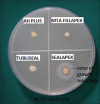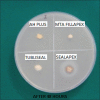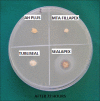Antimicrobial Efficacy of Different Endodontic Sealers against Enterococcus faecalis: An In vitro Study
- PMID: 29780734
- PMCID: PMC5946517
- DOI: 10.4103/jispcd.JISPCD_29_18
Antimicrobial Efficacy of Different Endodontic Sealers against Enterococcus faecalis: An In vitro Study
Abstract
Objective: The aim of this in vitro study is to compare the antimicrobial efficacy of four different endodontic sealers against Enterococcus faecalis.
Material and method: Four different endodontic sealers, namely, resin based (AH Plus), zinc oxide-eugenol based (Tubliseal), calcium hydroxide based (Sealapex), and mineral trioxide aggregate (MTA Fillapex) based were tested for their antimicrobial efficacy against E. faecalis using agar diffusion method. Four wells were made by the removal of agar at equidistant points and filled with freshly mixed respective root canal sealers and were inoculated with E. faecalis. All the three plates were incubated for a period of 72 h at 37°C under aerobic conditions. The diameter of inhibition zones was measured at 24, 48, and 72 h time intervals. Data obtained were statistically analyzed using one-way analysis of variance and unpaired t-test.
Results: All the tested sealers showed some bacterial growth inhibition of E. faecalis. Their efficacy in descending order of antibacterial activity was as follows: Sealapex > AH Plus > Tubliseal > MTA Fillapex. The efficacy of the root canal sealers decreased marginally with increase in their duration of action.
Conclusion: Antimicrobial efficacy of calcium hydroxide-based sealer was highest followed by resin-based sealer and was the least with MTA based sealer.
Keywords: AH plus; Enterococcus faecalis; Mineral trioxide aggregate Fillapex; Sealapex; Tubliseal.
Conflict of interest statement
There are no conflicts of interest.
Figures
Similar articles
-
In vitro Antibacterial Efficacy of Various Root Canal Sealers Against Enterococcus Faecalis.J Pharm Bioallied Sci. 2025 May;17(Suppl 1):S269-S271. doi: 10.4103/jpbs.jpbs_675_25. Epub 2025 Apr 29. J Pharm Bioallied Sci. 2025. PMID: 40510976 Free PMC article.
-
An Invitro Evaluation of Antimicrobial Efficacy and Flow Characteristics for AH Plus, MTA Fillapex, CRCS and Gutta Flow 2 Root Canal Sealer.J Clin Diagn Res. 2016 Aug;10(8):ZC104-8. doi: 10.7860/JCDR/2016/20885.8351. Epub 2016 Aug 1. J Clin Diagn Res. 2016. PMID: 27656550 Free PMC article.
-
Antibacterial activity of a new endodontic sealer against Enterococcus faecalis.J Can Dent Assoc. 2006 Sep;72(7):637. J Can Dent Assoc. 2006. PMID: 16978482
-
Antimicrobial efficacy of calcium silicate-based bioceramic sealers against Enterococcus faecalis and Staphylococcus aureus - An in vitro study.J Conserv Dent Endod. 2024 Jul;27(7):737-742. doi: 10.4103/JCDE.JCDE_215_24. Epub 2024 Jul 8. J Conserv Dent Endod. 2024. PMID: 39262595 Free PMC article.
-
Antibacterial activity of biodentine against Enterococcus faecalis: a systematic review.Front Dent Med. 2025 Jan 21;5:1498353. doi: 10.3389/fdmed.2024.1498353. eCollection 2024. Front Dent Med. 2025. PMID: 39917655 Free PMC article.
Cited by
-
Synthesis, Characterization, and Bioactivity of Mesoporous Bioactive Glass Codoped with Zinc and Silver.Int J Mol Sci. 2023 Sep 5;24(18):13679. doi: 10.3390/ijms241813679. Int J Mol Sci. 2023. PMID: 37761992 Free PMC article.
-
Apical microleakage in root canals with separated rotary instruments obturated with different endodontic sealers.J Conserv Dent. 2022 May-Jun;25(3):274-277. doi: 10.4103/jcd.jcd_569_21. Epub 2022 Jun 13. J Conserv Dent. 2022. PMID: 35836557 Free PMC article.
-
Influence of bioceramic sealers on dentinal tubule penetration and antimicrobial effectiveness: a systematic review and meta-analysis of in vitro studies.Odontology. 2024 Jul;112(3):672-699. doi: 10.1007/s10266-024-00904-6. Epub 2024 Feb 19. Odontology. 2024. PMID: 38374511
-
Comparative Evaluation of the Antimicrobial Efficacy of Endodontic Sealers Against Staphylococcus aureus and Streptococcus mutans: An In Vitro Study.Cureus. 2025 Mar 11;17(3):e80435. doi: 10.7759/cureus.80435. eCollection 2025 Mar. Cureus. 2025. PMID: 40225476 Free PMC article.
-
In vitro Antibacterial Efficacy of Various Root Canal Sealers Against Enterococcus Faecalis.J Pharm Bioallied Sci. 2025 May;17(Suppl 1):S269-S271. doi: 10.4103/jpbs.jpbs_675_25. Epub 2025 Apr 29. J Pharm Bioallied Sci. 2025. PMID: 40510976 Free PMC article.
References
-
- Arora R, Rawat P, Bhayya DP. A comparative evaluation of antimicrobial efficacy of three endodontic sealers: Endoflas FS, AH plus and sealapex against Enterococcus faecalis – An in vitro study. IOSR J Dent Med Sci. 2014;13:90–3.
-
- Sundqvist G, Figdor D, Persson S, Sjögren U. Microbiologic analysis of teeth with failed endodontic treatment and the outcome of conservative re-treatment. Oral Surg Oral Med Oral Pathol Oral Radiol Endod. 1998;85:86–93. - PubMed
-
- Grossman L. Antimicrobial effect of root canal cements. J Endod. 1980;6:594–7. - PubMed
LinkOut - more resources
Full Text Sources
Other Literature Sources





